

A game-specific adaptation in the Eastern Woodlands
By Larry Kinsella
SEAC, October 27th thru the 30th, 2010, Lexington KY
(up-dated 8/April/2016)
Although many theories abound, the use of the bannerstone, has yet to be understood. Ideas from increasing the velocity of the launched dart, to a silencer, to a mesh spacer, and almost everything in between, have been offered. In the following paper, another explanation will be presented.
Bannerstone
The word “Bannerstone” will be used to describe core or solid drilled stone, bone, and shell artifacts, constructed into a wide variety of shapes and sizes. Birdstones, gorgets, boatstones, and small stones, which may also have been tied to atlatls, will not be covered here, per se. Hopefully, their use will be explained at another time.
Webb mentions that Moorhead preferred the words “problematical forms” instead of “bannerstone” or “gorget”, when describing them because the latter terms inferred an undocumented knowledge of their use. Knoblock, on the other hand simply used the term “ceremonial” to define their function. The word “bannerstone” will be used here simply because, over the years, it has been the term used most often to describe these unusual artifacts.
Drilled bannerstones appear to be limited in their distribution, confining themselves to the Eastern Woodlands of the United States. Their distribution is one of the first clues to their function because, in the Eastern Woodlands, white tail deer were by far the mammal of choice for meat. Although the Eastern Woodlands are primarily East of the Mississippi, large areas in Missouri, Arkansas, and even Eastern Oklahoma can also be classified as Woodlands. Bannerstones are also reported from those areas.
The woodlands and/or wooded areas provide cover for the stalking of white-tail deer. This is important to the understanding of the bannerstone.
In the West, other sources of meat such as buffalo, elk, moose, antelope, a
•The distribution of drilled bannerstones appears to be isolated to the Eastern Woodlands. They appear nowhere else in the world.
nd mule deer were also hunted. Some of these were herd animals and were not necessarily stalked, mostly because of the wide-open terrain. Therefore, they used more flexible and in many cases, longer types of atlatls. These more flexible and /or longer atlatls may have helped with distance and possibly accuracy, to some extent.
Indian Knoll
Early work by C. B. Moore and later, more documented work, by Dr. William S. Webb, at the Indian Knoll site, in Kentucky, has shown a solid connection between bannerstones and atlatls. Disregarding the 6 or 7 instances where bannerstones and atlatl hooks and/or handles appear to be aligned, the sheer volume of associations between banners and hooks and/or handles, is not coincidental. In “The Development of the Spearthrower” Dr. Webb attributes a date of between 4,000 BC and 1,500 BC, to the atlatl components found at Indian Knoll. There are also 11 radiocarbon dates for this site spanning a period from 5700 to 3500 bp, uncalibrated (see Marquardt and Watson 2005:64). At most sites, the antler hooks and handles would have been disintegrated by now but the acidity of the soil was neutralized by the alkaline nature of the shell middens present at Indian Knoll. Other shell mounds also display this neutralizing of the soil but Indian Knoll is unique for its size and documented excavations.
Experiment
 Time to drill a, geniculate banner,
2.9cm. (1-1/8”) thick = 10 hours, 22 minutes
Time to drill a, geniculate banner,
2.9cm. (1-1/8”) thick = 10 hours, 22 minutes
Banners were thought to be ceremonial ,by many, because it was thought it must have taken a very long time to drill the stone. The author drilled this geniculate, using flint dust and river cane. Notice the tally mark on the cane. Only 2.9cm. (1-1/8 inch) of cane was lost. The hole was started with a flint flake (1-1/2 hours), then core-drilled in the hand.
In 1989, the author conducted an experiment to determine the time and effort needed to drill a hole in a bannerstone. After looking at Knoblock’s experiments using sand and cane, it was decided to try cane and flint dust. The reasoning was that flint dust simply should have been a core-drilling medium readily available to Archaic craftspeople. Knoblock had tried using flint but crushed it before use. The author used flint dust procured from extensive flintknapping activity to assimilate material readily available to ancient craftspeople.
The dust was winnowed over a tarp on a windy day. The tarp was pinched where it appeared too many fines were present and where the flint size seemed to be too large. Everything in between the pinches was poured into a jar for use in the experiment.
The author was able to drill a 1 1/8 inch deep hole into a banded slate geniculate bannerstone, in 10 hours and 22 minutes. In the process only 1 1/8 inch of cane was lost to the drilling process. This was much different than the extremely long time and huge cane loss suggested by Knoblock’s experiments.
The author’s experiment was started by scratching the area where the hole was to be drilled with a flint flake. This took 1-½ hours. Once the depression was deep enough to hold the cane in position, about 15 to 20 grains of flint dust were added, and the cane was twirled between the palms. Later a bow drill was tried but it spun the cane too fast making the flint dust travel up the sides rather than retaining it at the cutting end of the cane. It was decided to revert back to the hand-drill method. After 10 or 15 minutes, the grit would become rounded and another 15 or 20 grains were added. This was kept up until the hole was completed.
 (Photo by Pete Bostrom)
Removing the core from the cane drill.
(Photo by Pete Bostrom)
Removing the core from the cane drill.
Careful notes were taken and the author clocked himself in or out, when he took breaks. It should be noted that the 10 hours and 22 minutes were accrued by an amateur. An experienced craftsperson could probably produce the same results in two-thirds, the time. An interesting observation was the loss of cane during the experiment. It only took 1-1/8 inch of cane to produce a hole 1-1/8 inch deep.
 The upper core is an
ancient specimen, from Southern Illinois, while the lower example is the core
produced in the experiment.
The upper core is an
ancient specimen, from Southern Illinois, while the lower example is the core
produced in the experiment.
The idea that producing a hole in a bannerstone took days, instead of hours, has lead to the misunderstanding that bannerstones had to be much harder to make than they actually were.
 (Photo by Pete Bostrom)
A close-up, of
the tip of the cane core-drill ,after drilling the banner. Notice the striations
on the cane’s exterior. This, in turn, lead to
the thought that bannerstones could not have been used on atlatls to perform the
“ordinary” task of putting meat on the table, suggesting it would provide a
trivial return on the investment of time and energy used for their production.
(Photo by Pete Bostrom)
A close-up, of
the tip of the cane core-drill ,after drilling the banner. Notice the striations
on the cane’s exterior. This, in turn, lead to
the thought that bannerstones could not have been used on atlatls to perform the
“ordinary” task of putting meat on the table, suggesting it would provide a
trivial return on the investment of time and energy used for their production.
Dr. Webb stated that he thought bannerstones were some type of balance but did not offer a reason why they were preferred. Considering the bannerstone’s distribution, age, and drilled weight, along with the elasticity (or lack thereof) of the atlatl shaft, there are subtle hints as to its use. Its distribution, in the Eastern Woodlands, where it is easier to stalk, simply because of the amount and size of vegetation, suggests a link to white tail deer. Its age, from late Middle Archaic through Late Archaic also suggests a white-tail deer connection because by far, white tail are the largest source of mammal meat found in documented excavations, for those periods.
The drilled weight also suggests a white tail connection. Why go to all that trouble to drill a stone, for a counterbalance, when it would be easier to tie a simple rock to the atlatl? If a rock is tied to the atlatl, it is likely the lashings will become loose in such a high humidity environment. It would have to be tightened occasionally. A loose stone will slap the back of the atlatl, making a sound that will scare off a white tail. On the other hand, if the stone is drilled, and the shaft is passed through it, and it is glued to the atlatl, the need for lashings is eliminated. It should also be noted that, while white tail may be affected by noise, other game, might be minimally affected. Hence, the many different types of atlatl weights may also be other “game-specific” adaptations.
Elasticity, or as Webb states “elastic” or “inelastic” qualities, also plays a role in the understanding of bannerstones as atlatl weights. In the reexamination of the Indian Knoll collection, it was found that most of the bannerstones exhibited 9mm to 11 mm. holes. Of course there were some variations but that was about the average size. At the Bullseye site, in Illinois, the diameter generally was a few millimeters bigger.
![]() (Photo by Julie Morrow)
The finished atlatl, with
bannerstone.
(Photo by Julie Morrow)
The finished atlatl, with
bannerstone.
If an atlatl shaft were made to fit the banner and its accompanying hook, it would not be very “elastic”. If one considers the handles having even larger holes, as was usually the case, an even more “inelastic” atlatl, would be the result. Dr Webb compensated for this by widening and narrowing the atlatl shaft to allow the atlatl to flex and become more “elastic”. The author, through experimentation, has found this to create a weak spot,
 (Photo by Julie
Morrow)
The
arrow (the arrow is missing in this photo. The "weak spot" occurs where the
walnut main-shaft enters the bannerstone) points to the point at which a weak
spot occurs when the wooden handle is modified to fit through the banner, into
the antler hook. This weak spot is prone to breakage,especially where the
shaft enters the bannerstone. Making an atlatl with dimensions fitting the handle on one end and the
banner and hook on the other, presents one with a rather “inelastic” atlatl.
(Photo by Julie
Morrow)
The
arrow (the arrow is missing in this photo. The "weak spot" occurs where the
walnut main-shaft enters the bannerstone) points to the point at which a weak
spot occurs when the wooden handle is modified to fit through the banner, into
the antler hook. This weak spot is prone to breakage,especially where the
shaft enters the bannerstone. Making an atlatl with dimensions fitting the handle on one end and the
banner and hook on the other, presents one with a rather “inelastic” atlatl.
Recently, in dealing with the “weak spot”, the author has compensated by using river cane for the atlatl shaft. During visits to the Indian Knoll collection, the author noted that many of the atlatl handles were drilled about 2 or 3 millimeters larger than their associated banners and hooks, While cutting cane, it was noticed that a cane shaft of about 9mm. on the small end, would increase in size to about 11 or 12 mm. on the larger end, when obtaining atlatl-length pieces. In a bannerstone drilling experiment, conducted by the author, it was found that the cane drill would produce a hole slightly larger (0.5mm. or so) on one end of the banner, than the other. The larger end was the point at which drilling initiated and it became larger simply because the drilling grit (in this case, flint dust) had contacted that end for a longer period of time. Using cane to drill the banner evolved into using cane for the atlatl itself. Using cane allows the atlatl to fit the handle, banner, and hook with very little, if any, modification. It also incorporates the inherent strength of the cane and its elasticity to virtually eliminate the “weak spot” and provide a little “flex”.
 This
geniculate is being drilled, using a template. Axe-making debitage is being used
for the grit. The template is glued, temporarily, with hide glue. The template
was made, using a chert micro-drill and a chert reamer.
This
geniculate is being drilled, using a template. Axe-making debitage is being used
for the grit. The template is glued, temporarily, with hide glue. The template
was made, using a chert micro-drill and a chert reamer.
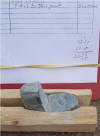 It took 33 minutes and
15 seconds to drill the banner this far. By using a template, instead of a chert
flake, an hour of labor was saved. Ancient craftsmen may have been able to
complete similar tasks in half the time. Eventually, this geniculate will have
two holes. Another hole will be drilled closer to the vertical section. When
both holes are completed, they will be joined to make one elongated hole,
typical of geniculates.
It took 33 minutes and
15 seconds to drill the banner this far. By using a template, instead of a chert
flake, an hour of labor was saved. Ancient craftsmen may have been able to
complete similar tasks in half the time. Eventually, this geniculate will have
two holes. Another hole will be drilled closer to the vertical section. When
both holes are completed, they will be joined to make one elongated hole,
typical of geniculates.
Stalking
While stalking a white tail deer, the benefits of attaching a bannerstone, become apparent. Setting up an ambush takes skill and the ancient hunters probably perfected their technique beyond our imagination. Hunting with an atlatl presents different problems than hunting with rifle or bow and arrow.
 Hunting with a bow,
allows the hunter to use more of the natural surroundings, to his advantage. The
vegetation provides better concealment. “Instinct shooting” works especially
well, in this setting.
Hunting with a bow,
allows the hunter to use more of the natural surroundings, to his advantage. The
vegetation provides better concealment. “Instinct shooting” works especially
well, in this setting.
The biggest problem presented while hunting with an atlatl, is having enough clear area to allow the atlatl and dart to be drawn back enough to provide a clean throw. For that reason, hunting from a tree stand is almost impossible. It cuts the “kill-zone” by about 80%. If right-handed, the throw can only be made to the extreme left, otherwise the drawback of the atlatl will hit the tree. Throwing to the right is out of the question unless the hunter can lean far enough from the tree to allow the required forward arm motion. It is probable that atlatlists hunted from the ground or natural ledges like bluffs or boulders. In that context, other problems arise.
The atlatlists have to get closer by stalking in order to keep the same trees and branches, providing their cover, from impeding their throw. In a wooded environment, white tail deer have the upper hand simply because of the amount of cover available. Longer, flexible atlatls would be of less use in a wooded setting, for stalking white tails, but seem more desirable in prairie or desert regions, for hunting herd-type animals.
 Holding the system in the “relaxed “position.
Holding the system in the “relaxed “position.
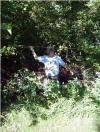 The atlatl should be held in the correct throwing position or the deer will bolt
when the atlatl and spear are raised into the correct position.
The atlatl should be held in the correct throwing position or the deer will bolt
when the atlatl and spear are raised into the correct position.
When stalking, knowledge of animal behavior is imperative. If the atlatlist sets up an ambush and the deer comes into view before the hunter sees it, the simple act of pulling back the atlatl to the loaded position creates enough movement to be immediately sensed by the deer.
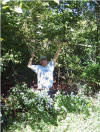 Stalking with the
atlatl requires enough room, overhead, for the atlatl and spear to clear any
overhanging vegetation. The sound of the system hitting a limb, for instance,
will spook the deer. Hunting from a deer stand would adversely impact the “kill
zone” by as much as 70%, because the atlatl will hit the tree when drawn back.
Stalking with the
atlatl requires enough room, overhead, for the atlatl and spear to clear any
overhanging vegetation. The sound of the system hitting a limb, for instance,
will spook the deer. Hunting from a deer stand would adversely impact the “kill
zone” by as much as 70%, because the atlatl will hit the tree when drawn back.
 There must also be
enough space for the follow-through.
There must also be
enough space for the follow-through.
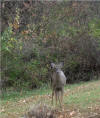 The atlatlist cannot throw when the deer
is looking , because the deer can simply side-step the atlatl dart. Most modern
bow hunters won’t shoot at a deer that’s looking at them, because the deer can
simply side-step the arrow. The modern bow has a “rest spot”, at full draw,
which allows the hunter to out-wait the deer until it looks away
The atlatlist cannot throw when the deer
is looking , because the deer can simply side-step the atlatl dart. Most modern
bow hunters won’t shoot at a deer that’s looking at them, because the deer can
simply side-step the arrow. The modern bow has a “rest spot”, at full draw,
which allows the hunter to out-wait the deer until it looks away
This results in escape.
Therefore, the hunter must be able to see the deer first and have their atlatl
in the “loaded” (spear knocked and pulled back) position before the deer spots
them. Once the deer sees the hunter, the hunter must not move or the shot is
gone. If the hunter tries to throw the dart while the deer is looking in their
direction, the deer will simply side step the dart and escape.
The deer will test the
hunter by grunting, stomping, and/or appearing to eat, only to look up quickly.
If there is any movement, escape results.
 Waiting for the deer to look away,
puts the atlatlist at a disadvantage because muscle fatigue occurs when holding
the spear with a regular atlatl.
Waiting for the deer to look away,
puts the atlatlist at a disadvantage because muscle fatigue occurs when holding
the spear with a regular atlatl.
Modern bow-hunters will not shoot a deer looking at them because they know the deer is fast enough to side step a modern arrow. This puts the hunter in the awkward position of out-waiting the deer. For the modern bow-hunter, this waiting period is compensated for by the bow. At full draw there is a “rest spot” where there is much less stress on the hunters musculature. For the atlatlist, the “rest spot” is achieved with the bannerstone.
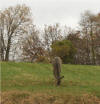 Notice how the deer is
still looking at the hunter, while feeding. Throwing at this point will also
result in escape. The author has experienced that it minimally takes about 2
minutes for the deer to look away long enough for a shot. Holding a spear with a
regular atlatl for 1 minute produces enough muscle stress to result in a poor
throw. Adding a counter-balance (bannerstone) simply allows the atlatlist to
out-wait the deer while maintaining enough muscle strength, to make an accurate
throw.
Notice how the deer is
still looking at the hunter, while feeding. Throwing at this point will also
result in escape. The author has experienced that it minimally takes about 2
minutes for the deer to look away long enough for a shot. Holding a spear with a
regular atlatl for 1 minute produces enough muscle stress to result in a poor
throw. Adding a counter-balance (bannerstone) simply allows the atlatlist to
out-wait the deer while maintaining enough muscle strength, to make an accurate
throw.
So, the deer is looking at the hunter, trying to make the hunter move so they can see if they are dangerous or not. In order to make the hunter move they will snort or grunt and watch very carefully for any sign of movement. If there’s movement, they’re gone. Sometimes they’ll stomp their hooves with the same intent. It is the author’s observation that within a minute or so, they will look down for very short periods, then look up quickly to see if there’s any movement at all. Again, any movement will result in escape. It takes about 2 or 3 minutes for the deer to look away long enough for the hunter to make the shot.
Here, holding an actual atlatl and dart is the easiest way to explain what happens. When holding a regular atlatl and dart for about 1 minute, it will be noticed that it becomes increasingly difficult to hold the stone point still. This is because a 2 or 3 ounce stone point, about 3 feet from the fulcrum or atlatl handle, needs to be balanced. To compensate for that weight, the atlatlist must pull the spear-tip upward putting stress on the wrist, shoulder, and elbow. In another 30 seconds muscles will start to cramp or tie-up, first, the wrist, then the shoulder, and then the elbow. If the deer stays for the minimum of 2 minutes before it looks away, muscles will be so cramped, the atlatlist couldn’t hit the broad side of a barn, much less with power.
When holding the atlatl with a bannerstone, for more than a minute, it becomes instantly apparent that the bannerstone is a counterbalance because it will ease muscles and the atlatlist will see that they can stand in the “loaded” position for several minutes or so with little stress on the wrist, shoulder, and/or elbow.
This counterbalance is no small thing. It increased the chances of putting meat on the table and, in some cases, may have been the determining factor for moving camp from one area to another for better hunting. The development of the bannerstone took thousands of years to evolve and its progression can be better understood by looking at the game it was taking, from a hunter’s perspective.
This may also explain those exceedingly large bannerstones that wouldn’t seem to be atlatl weights because they appear to be too heavy. There is no reason why some bannerstones should not have had a ritualistic or symbolic meaning. Any instrument, which provides food, may very well be able to commemorate the number of animals the hunter killed. But, let’s experiment with those oversized ones, to make sure they have no other function, before we jump the gun.
 Dr. Pontzer’s Human Evolutionary Biometrics Lab, at Washington
University, in St. Louis, MO.
Dr. Pontzer’s Human Evolutionary Biometrics Lab, at Washington
University, in St. Louis, MO.
On September 8th, 2010, Dr. John Kelly held the first experimental archaeology class at Washington University, in St. Louis. He asked the author to attend so the students could work with the idea of the bannerstone being used as a counter-balance. Dr. Herman Pontzer attended that class and, after some of the students held the atlatls with and without bannerstones, the class adjourned to his Human Evolutionary Biometrics Laboratory.
 Dr. Herman Pontzer’s Lab, September 8th,
2010 (photo by John Kelly)
Dr. Herman Pontzer’s Lab, September 8th,
2010 (photo by John Kelly)
To visually explain the counter-balance idea, he hooked the author up to an electromyography machine (EMG) that measures the electric waves produced by muscular activity. The author held a dart, without a bannerstone, for two minutes (the minimal amount of time it takes the deer to look away) then switched to one, with a bannerstone, for two minutes.
The results could be seen on his computer monitor and it showed that there was a marked difference between the two atlatls. There was much less strain on the muscles, using the bannerstone.
Summary
Bannerstones are NOT necessities, they are accessories
The bannerstone has been thought of as being a counterbalance for quite a while, but we have not understood why a counterbalance was preferred in the first place. By looking at the bannerstone as a game-specific adaptation, we can see its appearance in the archaeological record as a natural progression to a better and better white tail deer hunting weapon. We can see this through its distribution because they occur nowhere else on the planet other than the haunt of the white tail deer. Their total absence in other regions where herd-animals abound, is also telling.
Through experimentation, we now know that some bannerstones can be manufactured in much less time and with much less effort than previously thought. This has much bearing on our interpretation simply because an artifact that takes too much time to create makes us think it has to be more valuable and therefore less likely to be used in normal tasks like acquiring food. It also makes us lean toward the “ceremonial” interpretation.
By approaching this problem from a hunter’s prospective, we can better understand the use of the bannerstone/counterbalance idea and see why they became an inevitable progression for the atlatl in the eastern woodlands.
Special thanks to:
Dr. John Kelly
Dr. Patty Jo Watson
Dr. Herman Pontzer
Greg Perino (for info on bannerstone distribution)
•Val Haskins and Mary Lucas Powell, for giving us the chance to view the Indian Knoll collection in the late 80s.
Dave Klostermeier, Pete Bostrom, Charlie Laster, Dick Baugh, Errett Calahan, Bob Kitch, John Whitaker, Rod Laird, and all those wonderful Rabbit Stickers, and atlatlists ,who have influenced me over the years.
This paper is dedicated to Leonard Blake, who kept saying
“Larry, you should write up this $@%#.”
References cited:
Bost, Jerry. 1991. Bannerstone theory. Central States Archaeological Journal 38: Pages 72-74)
Hassen, Harold, and Kenneth Farnsworth. 1987. The Bullseye Site: A floodplain Archaic
mortuary site in the Lower Illinois River Valley. Springfield, IL: Illinois State Museum,
Reports of Investigations 42.
Knoblock, Byron W. 1939. Bannerstones of the North American Indian. Lagrange, IL.
Perkins, Bob. 1992. Stealth technology. Bulletin of Primitive Technology 4: (Pages 58-61)
Marquardt, William H., and Patty Jo Watson, editors. 2005. Archaeology of the Middle Green
River Region, Kentucky. Gainesville, FL: Florida Museum of Natural History, Institute of
Archaeology and Paleoenvironmental Studies, Monograph 5.
Moore, Clarence B. 1916. Some aboriginal sites on Green River, Kentucky. Journal of the
Academy of Sciences of Philadelphia, Second Series, Vol. XVI, Part 3.
Webb, William S. 1946. Indian Knoll, site Oh 2, Ohio County, Kentucky. Lexington:
Publications of the Department of Anthropology and Archaeology, University of Kentucky,
Reports in Anthropology, Vol. IV, Number 3, Part 1.
_____. 1950a. The Carlson Annis mound, site 5, Butler County, Kentucky. Lexington:
Publications of the Department of Anthropology, University of Kentucky, Vol. VII,
Number 4.
_____. 1950b. The Read shell midden, site 10, Butler County, Kentucky. Lexington:.Publications
of the Department of Anthropology, Reports in Anthropology, Vol. VII, Number 5.
_____. 1957. The development of the spearthrower. Lexington: Publications of the Department
of Anthropology, University of Kentucky, Occasional Papers in Anthropology No. 2.
Webb, W. S. and W. G. Haag. 1939. The Chiggerville site, site 1, Ohio County, Kentucky.
Lexington: Publications of the Department of Anthropology and Archaeology, Vol. IV,
Number 1.